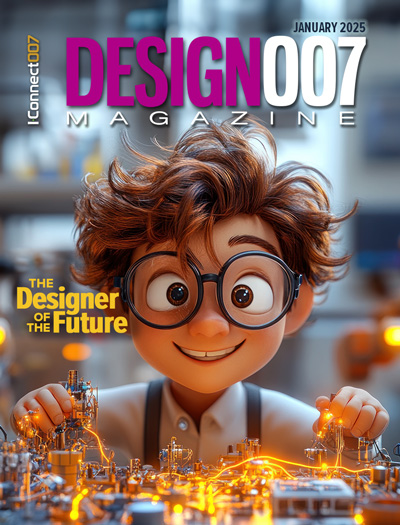-

- News
- Books
Featured Books
- design007 Magazine
Latest Issues
Current Issue
The Designer of the Future
Our expert contributors peer into their crystal balls and offer their thoughts on the designers and design engineers of tomorrow, and what their jobs will look like.

Advanced Packaging and Stackup Design
This month, our expert contributors discuss the impact of advanced packaging on stackup design—from SI and DFM challenges through the variety of material tradeoffs that designers must contend with in HDI and UHDI.

Rules of Thumb
This month, we delve into rules of thumb—which ones work, which ones should be avoided. Rules of thumb are everywhere, but there may be hundreds of rules of thumb for PCB design. How do we separate the wheat from the chaff, so to speak?
- Articles
- Columns
Search Console
- Links
- Media kit
||| MENU - design007 Magazine
Attention Students: NASA Launches Power Systems Student Essay Contest
November 7, 2024 | NASAEstimated reading time: 2 minutes
NASA’s fourth annual Power to Explore Student Challenge kicked off November 7, 2024. The science, engineering, technology, and mathematics (STEM) writing challenge invites kindergarten through 12th grade students in the United States to learn about radioisotope power systems, a type of nuclear battery integral to many of NASA’s far-reaching space missions.
Credit: NASA
Students are invited to write an essay about a new nuclear-powered mission to any moon in the solar system they choose. Submissions are due Jan. 31, 2025.
With freezing temperatures, long nights, and deep craters that never see sunlight on many of these moons, including our own, missions to them could use a special kind of power: radioisotope power systems. These power systems have helped NASA explore the harshest, darkest, and dustiest parts of our solar system and enabled spacecraft to study its many moons.
“Sending spacecraft into space is hard, and it’s even harder sending them to the extreme environments surrounding the diverse moons in our solar system,” said Nicola Fox, associate administrator, Science Mission Directorate at NASA Headquarters in Washington. “NASA’s Power to Explore Student Challenge provides the incredible opportunity for our next generation – our future explorers – to design their own daring missions using science, technology, engineering, and mathematics to explore space and discover new science for the benefit of all, while also revealing incredible creative power within themselves. We cannot wait to see what the students dream up!”
Entries should detail where students would go, what they would explore, and how they would use radioisotope power systems to achieve mission success in a dusty, dark, or far away moon destination.
Judges will review entries in three grade-level categories: K-4, 5-8, and 9-12. Student entries are limited to 275 words and should address the mission destination, mission goals, and describe one of the student’s unique powers that will help the mission.
One grand prize winner from each grade category will receive a trip for two to NASA’s Glenn Research Center in Cleveland to learn about the people and technologies that enable NASA missions. Every student who submits an entry will receive a digital certificate and an invitation to a virtual event with NASA experts where they’ll learn about what powers the NASA workforce to dream big and explore.
Judges Needed
NASA and Future Engineers are seeking volunteers to help judge the thousands of contest entries anticipated submitted from around the country. Interested U.S. residents older than 18 can offer to volunteer approximately three hours to review submissions should register to judge at the Future Engineers website.
The Power to Explore Student Challenge is funded by the NASA Science Mission Directorate’s Radioisotope Power Systems Program Office and managed and administered by Future Engineers under the direction of the NASA Tournament Lab, a part of the Prizes, Challenges, and Crowdsourcing Program in NASA’s Space Technology Mission Directorate.
Suggested Items
Teledyne HiRel Semiconductors Releases Wideband 50 GHz RF Switch
02/05/2025 | BUSINESS WIRETeledyne HiRel Semiconductors announces the availability of its latest rad-tolerant wideband 50 GHz RF switch, model TDSW050A2T. This switch operates from true DC to 50 GHz, delivering excellent RF performance down to zero Hertz, making this device ideal for many of today’s complex space and defense applications.
EXTOLL Collaborates with BeammWave and GlobalFoundries as Key SerDes IP Partner for Lowest Power High-Speed ASIC
02/04/2025 | GlobalFoundriesEXTOLL, a leading provider of high-speed and ultra-low-power SerDes and Chiplet connectivity, has been selected by BeammWave, an innovation leader in mmWave 5G/6G digital beamforming, as a key SerDes IP supplier for its next gen communication ASIC development portfolio on GlobalFoundries’ (GF) 22nm FD-SOI process technology, 22FDX®.
Koh Young Highlights Inspection Solutions at IPC APEX EXPO 2025
02/04/2025 | Koh YoungKoh Young, the industry leader in True3D measurement-based inspection solutions and the exclusive Premier Sponsor of IPC APEX EXPO 2025, invites electronics manufacturers to Booth 2130 for live demonstrations of its award-winning inspection technologies.
EXTOLL Collaborates with BeammWave and GlobalFoundries as a Key SerDes IP Partner for Lowest Power High-Speed ASIC
02/03/2025 | GlobalFoundriesEXTOLL, a leading provider of high-speed and ultra-low-power SerDes and Chiplet connectivity, has been selected by BeammWave, an innovation leader in mmWave 5G/6G digital beamforming, as a key SerDes IP supplier for its next gen communication ASIC development portfolio on GlobalFoundries’ (GF) 22nm FD-SOI process technology, 22FDX®.
Sierra Space’s Dream Chaser Spaceplane Successfully Passes NASA Testing Milestone in Preparation for Launch
01/31/2025 | BUSINESS WIRESierra Space, a leading commercial space company and defense tech prime that is Building a Platform in Space to Benefit Life on Earth®, announced today it has successfully completed and passed its Joint Test 10B milestone in collaboration with NASA on the Dream Chaser® spaceplane.


